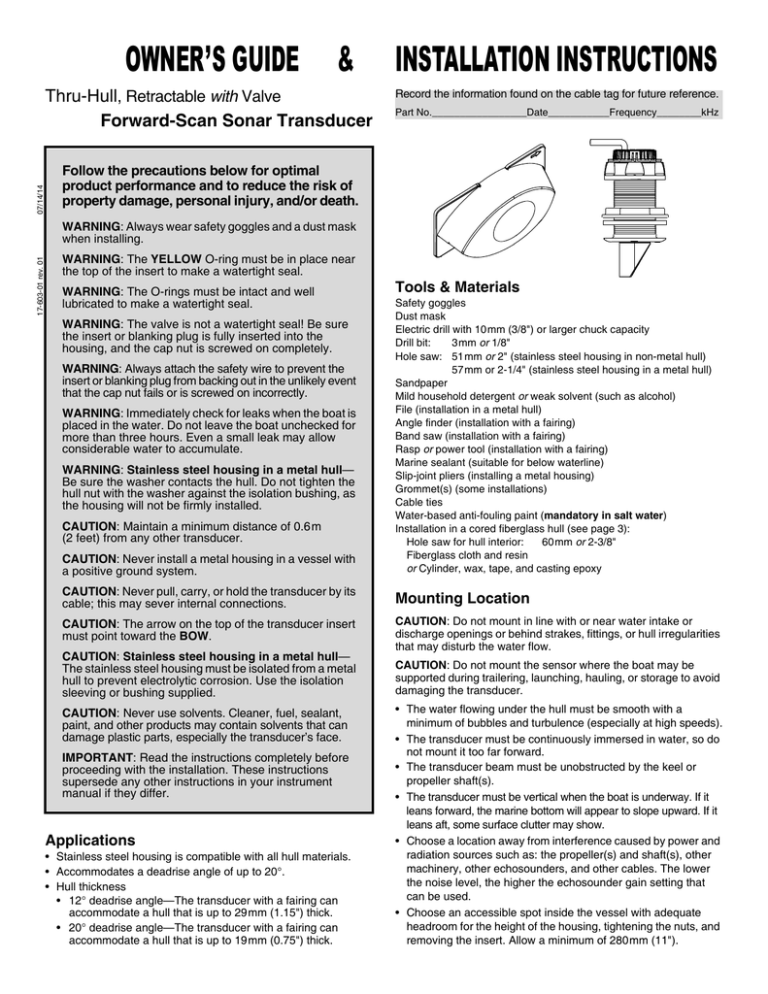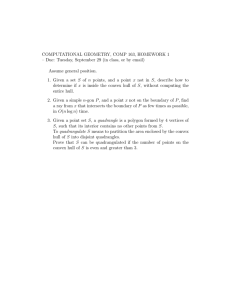ForwardScan Installation Manual, EN
advertisement

OWNER’S GUIDE & 07/14/14 Thru-Hull, Retractable with Valve Forward-Scan Sonar Transducer INSTALLATION INSTRUCTIONS Record the information found on the cable tag for future reference. Part No._________________Date___________Frequency________kHz Follow the precautions below for optimal product performance and to reduce the risk of property damage, personal injury, and/or death. 17-603-01 rev. 01 WARNING: Always wear safety goggles and a dust mask when installing. WARNING: The YELLOW O-ring must be in place near the top of the insert to make a watertight seal. WARNING: The O-rings must be intact and well lubricated to make a watertight seal. Tools & Materials CAUTION: Never install a metal housing in a vessel with a positive ground system. Safety goggles Dust mask Electric drill with 10mm (3/8") or larger chuck capacity Drill bit: 3mm or 1/8" Hole saw: 51mm or 2" (stainless steel housing in non-metal hull) 57mm or 2-1/4" (stainless steel housing in a metal hull) Sandpaper Mild household detergent or weak solvent (such as alcohol) File (installation in a metal hull) Angle finder (installation with a fairing) Band saw (installation with a fairing) Rasp or power tool (installation with a fairing) Marine sealant (suitable for below waterline) Slip-joint pliers (installing a metal housing) Grommet(s) (some installations) Cable ties Water-based anti-fouling paint (mandatory in salt water) Installation in a cored fiberglass hull (see page 3): Hole saw for hull interior: 60mm or 2-3/8" Fiberglass cloth and resin or Cylinder, wax, tape, and casting epoxy CAUTION: Never pull, carry, or hold the transducer by its cable; this may sever internal connections. Mounting Location CAUTION: The arrow on the top of the transducer insert must point toward the BOW. CAUTION: Do not mount in line with or near water intake or discharge openings or behind strakes, fittings, or hull irregularities that may disturb the water flow. WARNING: The valve is not a watertight seal! Be sure the insert or blanking plug is fully inserted into the housing, and the cap nut is screwed on completely. WARNING: Always attach the safety wire to prevent the insert or blanking plug from backing out in the unlikely event that the cap nut fails or is screwed on incorrectly. WARNING: Immediately check for leaks when the boat is placed in the water. Do not leave the boat unchecked for more than three hours. Even a small leak may allow considerable water to accumulate. WARNING: Stainless steel housing in a metal hull— Be sure the washer contacts the hull. Do not tighten the hull nut with the washer against the isolation bushing, as the housing will not be firmly installed. CAUTION: Maintain a minimum distance of 0.6m (2 feet) from any other transducer. CAUTION: Stainless steel housing in a metal hull— The stainless steel housing must be isolated from a metal hull to prevent electrolytic corrosion. Use the isolation sleeving or bushing supplied. CAUTION: Never use solvents. Cleaner, fuel, sealant, paint, and other products may contain solvents that can damage plastic parts, especially the transducer’s face. IMPORTANT: Read the instructions completely before proceeding with the installation. These instructions supersede any other instructions in your instrument manual if they differ. Applications • Stainless steel housing is compatible with all hull materials. • Accommodates a deadrise angle of up to 20°. • Hull thickness • 12° deadrise angle—The transducer with a fairing can accommodate a hull that is up to 29mm (1.15") thick. • 20° deadrise angle—The transducer with a fairing can accommodate a hull that is up to 19mm (0.75") thick. CAUTION: Do not mount the sensor where the boat may be supported during trailering, launching, hauling, or storage to avoid damaging the transducer. • The water flowing under the hull must be smooth with a minimum of bubbles and turbulence (especially at high speeds). • The transducer must be continuously immersed in water, so do not mount it too far forward. • The transducer beam must be unobstructed by the keel or propeller shaft(s). • The transducer must be vertical when the boat is underway. If it leans forward, the marine bottom will appear to slope upward. If it leans aft, some surface clutter may show. • Choose a location away from interference caused by power and radiation sources such as: the propeller(s) and shaft(s), other machinery, other echosounders, and other cables. The lower the noise level, the higher the echosounder gain setting that can be used. • Choose an accessible spot inside the vessel with adequate headroom for the height of the housing, tightening the nuts, and removing the insert. Allow a minimum of 280mm (11"). Boat Types (see Figure 1) • Displacement hull powerboats—Locate amidships near the centerline. The starboard side of the hull where the propeller blades are moving downward is preferred. • Planing hull powerboats—Mount well aft, on or near the centerline, and well inboard of the first set of lifting strakes to ensure that the transducer will be in contact with the water at high speeds. The starboard side of the hull where the propeller blades are moving downward is preferred. Outboard and I/O—Mount just forward of the engine(s). Inboard—Mount well ahead of the propeller(s) and shaft(s). Stepped hull—Mount just ahead of the first step. Boat capable of speeds above 25kn (29MPH)—Review the installation location and operating results of similar boats before proceeding. large displacement hulls small displacement hulls planing hulls stepped hull outboard and I/O fin keel sailboats • Fin keel sailboats—Mount on or near the centerline and forward of the fin keel 300–600mm (1–2'). • Full keel sailboats—Locate amidships and away from the keel at the point of minimum deadrise. full keel sailboats Figure 1. Installation Best location for transducer IMPORTANT: If installing the transducer with NO fairing, please disregard all references to a fairing and backing block. transom view Hole Drilling Cored fiberglass hull—Follow separate instructions on page 3. 1. Being sure the transducer will be a minimum distance of 0.6m (2 feet) from any other transducer, drill a 3mm or 1/8" pilot hole from inside the hull. If there is a rib, strut or other hull irregularity near the selected mounting location, drill from the outside. 2. Using the appropriate size hole saw, cut a hole from outside the boat. No fairing—Cut a hole perpendicular to the hull. Fairing—Be sure to hold the drill plumb, so the hole will be perpendicular to the water surface. 3. Sand and clean the area around the hole, inside and outside, to ensure that the sealant will adhere properly to the hull. If there is any petroleum residue inside the hull, remove it with either mild household detergent or a weak solvent (alcohol) before sanding. Metal hull—Remove all burrs with a file and sandpaper. 1. Measure the deadrise angle of the hull at the selected location (see Figure 2). 2. Tilt the band saw table to the measured angle and secure the cutting fence (see Figure 3). 3. Place the fairing on the table, so the cutting guide rests against the fence. The arrows will be pointing toward you for installation on the starboard side of the boat or away from you for installation on the port side. 4. Adjust the cutting fence, so the fairing will be cut in about two equal parts. The section that will become the fairing must be no less than 2mm (3/32") at its thinnest dimension. 5. Recheck steps 1 through 4. Then cut the fairing. 6. Shape the fairing to the hull as precisely as possible with a rasp or power tool. 7. Use the remaining section of the fairing with the cutting guide for the backing block. 2 deadrise angle parallel to waterline Figure 2. Deadrise angle of the hull band saw table cutting guide deadrise angle fence Cutting the Fairing CAUTION: The arrows on the fairing will point forward toward the bow. Be sure to orient the fairing on the band saw, so the angle cut matches the intended side of the hull and not the mirror image. slope of hull Figure 3. Cutting the Fairing arrow end for installation on starboard side of the hull Bedding CAUTION: Be sure the surfaces to be bedded are clean and dry. Apply a 2mm (1/16") thick layer of marine sealant to the flange of the housing that will contact the hull/fairing and up the sidewall of the housing (see Figure 4). The sealant must extend 6mm (1/4") higher than the combined thickness of the hull, washer, and hull nut and (if used) the fairing and backing block or isolation bushing. This will ensure there is marine sealant in the threads to seal the hull and hold the hull nut securely in place. Fairing—Fill all the cavities in the fairing and the backing block. This will ensure there is sufficient marine sealant to hold the fairing and the backing block securely against the hull. Metal hull and NO fairing—To prevent electrolytic corrosion, the stainless steel housing must be isolated from the metal hull. Slide the isolation bushing onto the housing. Apply additional sealant to the surfaces of the bushing that will contact the hull, filling any cavities in and around the bushing. NO fairing non-metal hull with insert in place fairing (12° shown) aft view NO fairing metal hull (isolation sleeve used with metal hull only) detail insert cap insert cap nut housing housing hull nut safety wire washer backing block hull nut washer fairing thickness min. 2mm (3/32") hull housing hull nut washer hull hull (metal) isolation sleeve isolation bushing fairing marine sealant on flange and sidewall of housing BOW ► marine sealant on flange and sidewall of housing and fairing and backing block that contacts the hull marine sealant on flange and sidewall of housing and isolation bushing where it contacts the hull Figure 4. Bedding and installing Metal hull and fairing—To prevent electrolytic corrosion, the stainless steel housing must be isolated from the metal hull. Slide the isolation sleeve over the bedded sidewall of the housing as far down as possible. Apply a 2mm (1/16") thick layer of the marine sealant to the outside of the sleeve. Be sure you have filled all the cavities in the fairing and the backing block. Installing the Housing 1. If you are using a fairing or isolation bushing, slide it onto the housing now. From outside the hull, push the housing (with any fairing or isolation bushing in place) into the mounting hole using a twisting motion to squeeze out excess sealant (see Figure 4). Fairing—Take care to align the fairing with the long side parallel to the centerline of the boat. Metal hull and fairing—Be sure the isolation sleeve is between the transducer stem and the hull. However, the isolation sleeve must be below the hull nut to prevent the sleeve from interfering with tightening the nut. 2. From inside the hull, slide the backing block (if installing with a fairing) onto the housing, being sure the arrows point forward toward the bow. Slide the washer onto the housing. Metal hull and NO fairing—Be sure the washer contacts the hull. Do not tighten the hull nut with the washer against the isolation bushing as the housing will not be firmly installed. If necessary, sand the isolation bushing until the washer rests against the hull. 3. Screw the hull nut in place. Tighten it with slip-joint pliers. Cored fiberglass hull—Do not over tighten, crushing the hull. Wood hull—Allow the wood to swell before tightening the hull nut. 4. Remove any excess marine sealant on the outside of the hull to ensure smooth water flow under the transducer. Installing the Insert 1. O-rings must be intact and well lubricated to make a watertight seal. After the marine sealant cures, inspect the O-rings on the insert (replace if necessary) and lubricate them with the silicone lubricant supplied (see Figure 7). Be sure the YELLOW O-ring is in place near the top. Also lubricate the bore of the housing above the valve. 2. The insert must be fully inserted into the housing and the cap nut screwed on completely to make a watertight seal. Slide the insert into the housing with the arrow on the top pointing forward toward the BOW (see Figure 4). 3. Screw the cap nut several turns until the threads are engaged. Being sure the arrow on the top of the insert is pointing forward toward the bow, continue to tighten the cap nut completely. Be careful not to rotate the housing and disturb the sealant. Hand tighten only. Do not over tighten. 4. Attach the safety wire to prevent the insert from backing out in the unlikely event that the cap nut fails or is screwed on incorrectly. Wrap one end of the safety wire tightly around the housing and twist it together with the long end. Keeping the wire taut, lead the wire straight up and through one eye in the insert. Thread the wire through the eye a second time. Twist the wire securely to itself. Cable Routing & Connecting CAUTION: If your transducer came with a connector, do not remove it to ease cable routing. Removing the waterproof connector or cutting the cable, except when using a watertight junction box, will void the transducer warranty. 1. Route the cable to the instrument being careful not to tear the cable jacket when passing it through the bulkhead(s) and other parts of the boat. Use grommets to prevent chaffing. To reduce electrical interference, separate the transducer cable from other electrical wiring and the engine. Coil any excess cable and secure it in place with cable ties to prevent damage. 2. Refer to the instrument owner’s manual to connect the transducer to the instrument. Checking for Leaks When the boat is placed in the water, immediately check around the transducer for leaks. Note that very small leaks may not be readily observed. Do not leave the boat in the water for more than 3 hours before checking it again. If there is a small leak, there may be much bilge water accumulation after 24 hours. If a leak is observed, repeat “Bedding” and “Installing” immediately (see page 2). Installation in a Cored Fiberglass Hull The core (wood or foam) must be cut and sealed carefully. The core must be protected from water seepage, and the hull must be reinforced to prevent it from crushing under the hull nut allowing the housing to become loose. CAUTION: Completely seal the hull to prevent water seepage into the core. 1. Drill a 3mm or 1/8" pilot hole from inside the hull. If there is a rib, strut, or other hull irregularity near the selected mounting location, drill from the outside. (If the hole is drilled in the wrong location, drill a second hole in a better location. Apply masking tape to the outside of the hull over the incorrect hole and fill it with epoxy.) 3 pour in casting epoxy 9-12 mm (3/8-1/2") larger than the hole through the hull’s outer skin inner skin insert core outer skin solid or hollow cylinder Figure 5. Preparing a cored fiberglass hull 2. Using a 51mm or 2" hole saw, cut the hole from outside the hull through the outer skin only (see Figure 5). 3. From inside the hull, use a 60mm or 2-3/8" hole saw to cut through the inner skin and most of the core. The core material can be very soft. Apply only light pressure to the hole saw after cutting through the inner skin to avoid accidentally cutting the outer skin. 4. Remove the plug of core material so the inside of the outer skin and the inner core of the hull are fully exposed. Sand and clean the inner skin, core, and the outer skin around the hole. 5. If you are skilled with fiberglass, saturate a layer of fiberglass cloth with a suitable resin and lay it inside the hole to seal and strengthen the core. Add layers until the hole is the correct diameter. Alternatively, a hollow or solid cylinder of the correct diameter can be coated with wax and taped in place. Fill the gap between the cylinder and hull with casting epoxy. After the epoxy has set, remove the cylinder. 6. Sand and clean the area around the hole, inside and outside, to ensure that the marine sealant will adhere properly to the hull. If there is any petroleum residue inside the hull, remove it with either mild household detergent or a weak solvent (alcohol) before sanding. 7. Proceed with “Bedding” and “Installing” on page 2. Anti-fouling Paint Surfaces exposed to salt water must be coated with anti-fouling paint. Use water-based antifouling paint only. Never use ketone-based paint, since ketones can attack many plastics possibly damaging the transducer. insert Figure 7. Replacing the O-rings so there is no gush of water into the boat. Always use the insert or the blanking plug secured with the safety wire for a watertight seal. Using the Blanking Plug To protect the insert, use the blanking plug: • When the boat will be kept in salt water for more than a week. • When the boat will be removed from the water. • When aquatic growth buildup on the insert is suspected due to inaccurate readings from the instrument. 1. The O-rings must be intact and well lubricated to make a watertight seal. On the blanking plug, inspect the O-rings (replace if necessary) and lubricate them with the silicone lubricant supplied or petroleum jelly (Vaseline®) (see Figure 7). 2. Remove the insert from the housing by removing the safety wire and unscrewing the cap nut (see Figure 4). This will jack out the insert. Grasp the insert and remove it with a slow pulling motion. Slide the blanking plug into the housing. Be sure the blanking plug is fully inserted. Screw the cap nut several turns until the threads are engaged. Continue to tighten the cap nut completely. Hand tighten only. Do not over tighten. NOTE: In the very unlikely event that the valve breaks, replace the housing the next time the boat is hauled. 3. Reattach the safety wire to prevent the blanking plug from backing out in the unlikely event that the cap nut fails or is screwed on incorrectly. Cleaning the Insert below lower O-ring Aquatic growth can accumulate rapidly on the transducer’s face reducing performance within weeks. Clean the insert with a Scotch-Brite® scour pad and mild household detergent, being careful to avoid making scratches. If fouling is severe, lightly wet sand it with fine grade wet/dry paper. exposed end Winterizing lower O-ring Reapply paint every 6 months or at the beginning of each boating season. Paint the following surfaces (see Figure 6): housing After the boat has been hauled for winter storage, remove the blanking plug to let the water drain away before reinserting it. This will prevent any water from freezing around the blanking plug and possibly cracking it. Replacement Transducer & Parts bore up 30mm (1-1/4") exterior of flange Figure 6. Anti-fouling paint Operation & Maintenance How the Valve Works The valve is not a watertight seal! The transducer incorporates a selfclosing valve which minimizes the flow of water into the boat when the insert is removed. The curved flap valve is activated by both a spring and water pressure. Water pushes the flap valve upward to block the opening, 4 blanking plug small black O-ring hull thickness • Insert below the lower O-ring • Exposed end of the insert • Exterior flange of the housing • Bore of the housing up 30mm (1-1/4") • Blanking plug below the lower O-ring including the exposed end yellow O-ring The information needed to order a replacement transducer is printed on the cable tag. Do not remove this tag. When ordering, specify the part number, date, and frequency in kHz. For convenient reference, record this information on the top of page one. Lost, broken, or worn parts should be replaced immediately. Blanking Plug 000-12230-001 Fairing 000-12231-001 O-ring Kit 000-12232-001 Housing Kit 000-11669-001 Obtain parts from your instrument manufacturer or marine dealer. Customer Care Tel: Email: 1-800-628-4487 ns-support@navico.com




